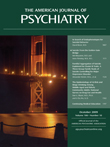Dr. Pope Replies
To the Editor: We agree with virtually all of the points raised by Drs. Scally and Tan, except for a minor semantic issue regarding their suggestion that anabolic steroid-induced hypogonadism represents a possible “confounding variable” in the diagnosis of anabolic-androgenic steroid dependence. To explain, we need to carefully define our terms. Anabolic steroid-induced hypogonadism is certainly a common physiologic response to chronic anabolic-androgenic steroid exposure, and it may contribute to anabolic-androgenic steroid withdrawal symptoms. Withdrawal symptoms, in turn, are a cluster of physical and psychological symptoms that may occur after discontinuing a drug that induces physiological dependence. Withdrawal symptoms are only one of the seven DSM-IV criteria for substance dependence and are neither necessary nor sufficient for a DSM-IV diagnosis of substance dependence. With these definitions in mind, then, we would say that anabolic steroid-induced hypogonadism represents simply one underlying mechanism for the etiology of anabolic-androgenic steroid withdrawal symptoms and should not be considered a confounder for making a DSM-IV diagnosis of anabolic-androgenic steroid dependence.
As an example, opioid withdrawal is caused in part by abnormal signaling at central opioid receptors (1) . However, this abnormal receptor activity is not a “confounding variable” in diagnosing opioid dependence. Rather, it is one of the underlying mechanisms of opioid withdrawal, and opioid withdrawal, in turn, is a frequent (but not necessary) criterion for diagnosing opioid dependence. Similarly, if an anabolic-androgenic steroid user suppresses his own testosterone production as a result of prolonged exogenous anabolic-androgenic steroid administration and then develops consequent hypogonadal symptoms upon withdrawing (2) , these withdrawal symptoms would legitimately count as one criterion (although not a necessary criterion) for the diagnosis of anabolic-androgenic steroid dependence.
On the basis of these considerations, we would agree with Drs. Scally and Tan that anabolic steroid-induced hypogonadism needs to be differentiated from anabolic-androgenic steroid dependence, since not all patients who suffer from anabolic steroid-induced hypogonadism will qualify for a diagnosis of anabolic-androgenic steroid dependence. However, we would suggest that anabolic steroid-induced hypogonadism does not disqualify an individual from a diagnosis of anabolic-androgenic steroid dependence either. Instead, anabolic steroid-induced hypogonadism represents one of the primary mechanisms of anabolic-androgenic steroid withdrawal and physiological dependence.
1. Waldhoer M, Bartlett SE, Whistler JL: Opioid receptors. Annu Rev Biochem 2004; 73:953–990Google Scholar
2. Kanayama G, Brower KJ, Wood RI, Hudson JI, Pope HG: Anabolic-androgenic steroid dependence: an emerging disorder. Addiction 2009 (in press)Google Scholar



